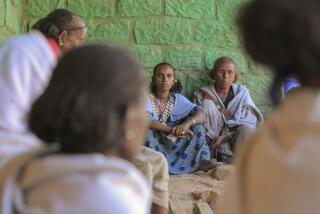Ethiopians Start Transition to Life in Israel : Airlift: Newcomers get checkups and clothing. The absorption period could be difficult.
- Share via
JERUSALEM — Still rejoicing over its dramatic airlift of Ethiopian Jews, Israel began Sunday to find homes, jobs and schools for the 14,000 newcomers, some of whom have never switched on a light bulb.
At temporary living centers across Israel, doctors gave check-ups and volunteers distributed clothing, taught the immigrants to use kitchen utensils and toilets and collected lists of names to aid relatives seeking family members.
Most of the immigrants arrived with only the clothes they were wearing, and broadcasts repeatedly appealed for clothing donations to be dropped at local post offices.
“It’s crazy, I have been going nonstop,” said Meir Edelstein, an immigration official running one of the temporary living centers in a former Jerusalem hotel housing 170 immigrants.
The rescue operation, which was accomplished in just over 33 hours, was planned with U.S. diplomatic assistance made possible after Israel pledged that the Ethiopian Jews would not be directed to the occupied territories captured in the 1967 Middle East War.
Avi Pazner, top aide to Prime Minister Yitzhak Shamir, said: “Israel told the United States it had no intention of settling the Ethiopians on occupied land.”
The rescue mission brought to 37,000 the number of Ethiopians living in Israel but 24,000 of them, including the newcomers, live in 100 temporary housing centers. The newcomers arrived at a time when Israel is struggling to accommodate tens of thousands of Soviet immigrants.
Since the Ethiopians’ arrival on Friday and Saturday, officials have mostly prohibited the new immigrants from leaving the centers, fearing that they may spread disease or get lost. Edelstein said that until name registers are completed and the immigrants are immunized, they will stay indoors.
Doctors have said that many of the Ethiopians suffer from serious illnesses, including tuberculosis, malaria, hepatitis, eye infections and isolated cases of meningitis.
Edelstein has organized volunteers to run play groups, Hebrew classes and kindergartens to keep the newcomers busy until they are processed.
“This situation may continue up to three weeks to a month,” he said, adding that teddy bears and toys donated by Israelis have helped.
Uri Gordon, head of immigration at the quasi-governmental Jewish Agency, responsible for transporting and settling newcomers, said the absorption process may be more difficult than the airlift.
“I am very worried for their future, both in terms of housing and employment. If we don’t do something about this, our joy today is liable to turn into tears over Israel’s failure to absorb immigrants,” Gordon told the daily Hadashot.
An influx of more than 250,000 Soviet Jewish immigrants since mid-1989 has already created a severe housing shortage and soaring unemployment.
“Well, we have lived only on miracles and maybe there will be another one,” Edelstein said. He estimated that most Ethiopians would stay in the agency-run housing centers for at least two years.
The looming hardships did not faze 45-year-old Katama Tasama, mother of seven, who was reunited with her nine siblings and parents after nine years.
“It was difficult in Addis Ababa, but we were received well here and we are happy,” she said.
Her eldest son, Mekuriau, smiled and nodded.
“It is great, just as I thought it would be,” he said. His only regret was that he hadn’t been allowed to walk through Jerusalem yet.
Tasama also was worried about a daughter and her children, who got lost during the airlift. She hoped to find them later Sunday, when a special radio broadcast would say where each immigrant is being held.
The huge airlift, called Operation Solomon, left about 2,000 Jews stranded in rebel-held areas of Ethiopia. The government has promised to do everything possible to get them out, but the assurance has failed to ease the anxieties of those searching for their families.
In addition, up to 3,000 Ethiopians were turned away from the rescue flights to Israel because they failed to meet Israel’s definition of a Jew.
In many cases it was because they had converted to Christianity. Others contend they simply were left off a census of Ethiopian Jews taken more than a decade ago.
“We faced a very difficult dilemma. If we brought everyone who just claimed to be Jewish, it could have amounted to hundreds of thousands more and not only thousands,” said Simcha Dinitz, chairman of the Jewish Agency.
Dinitz said he knew of 2,000 Ethiopian Jews who converted to Christianity and could not join the thousands who flew out.
Abraham Negisay of the Ethiopian Immigrants’ Assn. told Israel Radio that 3,000 people were left behind.
Israeli rabbis recognized the Ethiopian Jews as part of the faith in a 1973 ruling by then-Chief Sephardic Rabbi Ovadiah Yosef. Some rabbis ruled that the Ethiopians are descended from the lost Israelite tribe, Dan.
Israel’s Law of Return entitles any Jew to immigrate and receive citizenship automatically. The law recognizes as a Jew someone born to a Jewish mother or a convert to Judaism. It does not accept Jews who have converted to another faith.
Had Israel’s coalition government flouted these rules, it could have lost the support of the Orthodox parties that keep it in power and apply Jewish law carefully to the question of who is a Jew.
Most of the 14,000 Ethiopian evacuees established their Judaism at the Israeli Embassy in Addis Ababa over the past year.
More to Read
Sign up for Essential California
The most important California stories and recommendations in your inbox every morning.
You may occasionally receive promotional content from the Los Angeles Times.













